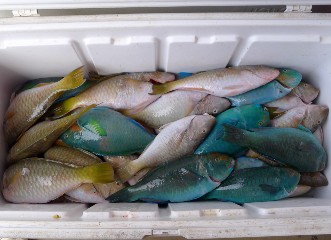Parrotfishes (Scaridae)



Catch fish using nets, spear, hook and line, or traps. Be mindful of ciguatera toxin and check the news for a possible outbreak in the area.
Keep fish chilled in a cooler or refrigerator. Can be frozen for longer storage.
J. Hollyer


Parrotfishes are known for their beak-like mouth andbright colors. They generally have a long body and large scales with smooth edges. Colors of the fish change with growth and gender from brown or gray with white stripes during the young phase and bright combinations of green, blue, or pink at the mature phase (Division of Aquatic and Wildlife Resources, Guam Department of Agriculture).
1. Bicolor parrotfish (Cetoscarus bicolor)
Has a long-pointed head and two noticeable color patterns. Can be found in clear lagoon and seaward reefs.
2. Bullethead parrotfish (Chlorurus sordidus)
Has many shade and pattern variations of color. Can be found in shallow reef flats, lagoon, and seaward reefs.
3. Filament-fin parrotfish (Scarus altipinnis)
Has one of the top middle rays/spines grow slightly longer when males are fully mature. The younger fish has a yellow head and striped to spotted body. Can be found in outer reef flats, clear lagoon, and seaward reefs.
4. Gibbus parrotfish (Chlorurus microrhinos)
Also known as steephead parrotfish, it has a bright blue streak and patch behind the corner of the mouth. Can be found in lagoon and seaward reefs. Younger fish swim by themselves, but mature fish swim in schools.
5. Humphead parrotfish (Bolbometopon muricatum)
Is very large for a parrotfish. Can be found swimming in schools on clear outer lagoon and seaward reefs.
6. Pacific longnose parrotfish (Hipposcarus longiceps)
Has a broad longitudinal orange stripe during the young phase. Can be found in lagoon reefs among coral rubble or over sandy areas, and off seaward reefs.
7. Palenose parrotfish (Scarus psittacus)
Is commonly seen swimming in large schools of mixed species. Can be found in reef flats, lagoon, and seaward reefs between corals.
8. Redlip parrotfish (Scarus rubroviolaceus)
Also known as the ember parrotfish, it is often bi-colored during both the young and mature phase with a dark front-half body. Can be found in seaward reefs near rocky bottoms.
9. Tan-faced parrotfish (Chlorurus frontalis)
Has noticeable tan facial markings. Can be found swimming in groups along exposed reef flats and seaward reefs.
10. Yellowband parrotfish (Scarus schlegeli)
Develops dark greenish markings around the lip with maturity. Can be found in lagoon and seaward reefs with plenty of coral growth.